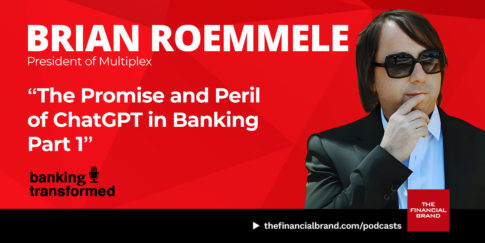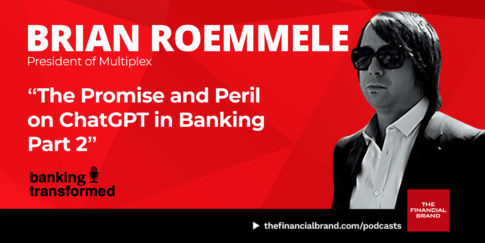The banking industry is in the very early days of exploring how generative AI models like ChatGPT can be applied to transform financial services. Many institutions are beginning to run small-scale pilot projects or proofs of concept to evaluate potential use cases in customer experience enhancements, back-office automation, risk assessment and fraud detection as well as product innovation. While generative AI offers benefits, financial institutions must also navigate challenges, minimizing potential flaws of this nascent technology.
 To gain insightful commentary on both the tremendous potential benefits as well as inherent risks new AI capabilities could bring to banks and credit unions, we conducted a two-part interview with Brian Roemmele, a prominent thought leader and expert on digital innovation and emerging technologies, for the Banking Transformed podcast. He offered a balanced perspective on how financial institutions can embrace the upside of generative AI like ChatGPT while also carefully mitigating downside risks.
To gain insightful commentary on both the tremendous potential benefits as well as inherent risks new AI capabilities could bring to banks and credit unions, we conducted a two-part interview with Brian Roemmele, a prominent thought leader and expert on digital innovation and emerging technologies, for the Banking Transformed podcast. He offered a balanced perspective on how financial institutions can embrace the upside of generative AI like ChatGPT while also carefully mitigating downside risks.
Listen to parts 1 and 2 of the podcast with Brian Roemmele:
The Promise and Peril of ChatGPT in Banking (Part 1)
The Promise and Peril of ChatGPT in Banking (Part 2)

Are You Ready for a Digital Transformation?
Unlock the potential of your financial institution's digital future with Arriba Advisors. Chart a course for growth, value and superior customer experiences.

Unlocking Digital Acquisition: A Bank’s Journey to Become Digital-First
This webinar will offer a comprehensive roadmap for digital marketing success, from building foundational capabilities and structures and forging strategic partnerships, to assembling the right team.
Read More about Unlocking Digital Acquisition: A Bank’s Journey to Become Digital-First
Enhancing Customer Experiences with Personalized AI
A major opportunity Roemmele highlighted during the interview is using ChatGPT and similar models to provide hyper-personalized customer service and advice. “Banking is absolutely ripe for conversational interfaces,” says Roemmele. “And what we’re seeing with some of these large language models is the ability to really create conversational experiences between consumers, small businesses and financial institutions.”
Roemmele envisions banks training individual AI models for each customer using their personal financial data and transaction history. Over time, these “personal banker bots” could gain deep insights into every customer’s unique circumstances to offer tailored recommendations on budgeting, investing, retirement planning and other financial challenges.
“Imagine a scenario with a financial institution where you’re talking to an interface that can understand your particular financial picture, make recommendations on how to allocate funds, think about planning for retirement or buying a house. Those types of conversational interfaces are coming.”
— Brian Roemmele
The power of this technology is that the more the AI interacts with a specific customer over time, the more personalized it can become at understanding their preferences and tailoring recommendations. This stands in contrast to the often rigid and repetitive scripted conversations with current non-AI chatbots.
“If you do it with care and you do it with dignity and permission by offering value to the client, by understanding more of the dimension of the milestones in life that that client is going through, your ability to finely tether an output is phenomenal,” states Roemmele.
An added benefit of conversational AI is that, when customers do need help, AI agents can provide rapid answers by quickly parsing questions and referencing vast knowledge bases rather than making customers wait on hold for the next available human agent. Generative AI also provides value by proactively offering personalized product recommendations, money-saving tips and basic financial planning or investment guidance tailored specifically to each customer’s risk tolerance, time horizon, current holdings and other factors.
Finally, as Roemmele explains, by continuously analyzing previous interactions, AI chatbots can assess customer sentiment, identify pain points, and loop in human agents as required.
Read more:
- Ally Taking ChatGPT Slow, But Could Be Using It by Yearend
- The Best Way to Implement GenAI (and Avoid Random Acts of Digital)
Streamlining Banking Operations with AI
Beyond customer-facing applications, Roemmele notes tremendous potential for large language models like ChatGPT to automate repetitive processes and make operations more efficient across the banking industry. Intelligent systems like ChatGPT can take over high volume, routine tasks such as checking account openings, loan processing, customer onboarding and other workflows that today require extensive manual effort.
Large language models can also analyze and extract key data from documents like contracts, financial statements and customer emails much faster than any human. Additionally, generative AI allows for auto-generating various reporting such as financial, regulatory, management and more based simply on a few prompts, rather than having analysts spend hours compiling such reports manually.
“There’s tremendous potential in the back office where you may have some very manual processes, reconciling accounts, moving data from system to system. Those are things that could be highly automated by these large language models,” states Roemmele. Generative AI can expedite content creation by automatically generating blog posts, social media updates, marketing emails and other customer-facing copy tailored to banking by providing the system with high-level directional input.
Roemmele stresses that AI should be used to augment human capabilities rather than replace jobs. For instance, instead of coding from the ground up, bank developers can use AI conversationally to generate code and applications simply by describing requirements in plain language.
“AI should never be used to replace a single employee. AI should be used to empower employees to be 10 times, at very minimum, seven times more powerful. It’s like a lever. The more you give this person the ability to have the leverage of standing on the shoulders of AI, the more powerful that individual becomes within the organization.”
— Brian Roemmele
Bottom line, by taking an empowerment-driven approach, banks can drive efficiency gains without the risks of mass job losses.
Read more:

Building Guardrails to Mitigate Risks as Banks Adopt Generative AI
During our two-part interview, Roemmele didn’t just focus on the benefits of Chat GPT and generative AI tools. He also extensively discussed risks that must be addressed, with model bias being a top concern.
“These models are only as good as the data we put into them,” Roemmele warns. “There could be areas where there’s bias built in. And that bias could play out in the recommendations made to consumers and small businesses.”
To mitigate bias issues, Roemmele recommended financial institutions build internal AI models trained only on their proprietary data. With the right processes, banks can minimize risk factors and keep AI outputs safe and productive. These processes include rigorous data governance practices to ensure data quality, accuracy and privacy. Second, Roemele recommends comprehensive model validation and testing procedures should be adopted to identify potential biases, errors or ethical concerns in AI-generated content. Additionally, continuous monitoring and auditing mechanisms can help detect and address any deviations or unexpected outcomes.
Roemmele further cautions that generative AI models can sometimes produce dangerous or nonsensical outputs if not constrained properly. He advises using a technique called “prompt engineering” to carefully frame queries and steer ChatGPT to give useful responses.
“The people who are most qualified to prompt AI are not technical people, and are not people from the AI community, because they see the model through a different lens. The people who I’ve found, and corporations are finding — and they’re hiring these folks as soon as they are trained — are people with linguistics backgrounds and backgrounds in even poetry, ancient history, philosophy, psychology.”
— Brian Roemmele
Collaboration between AI experts, legal professionals and domain specialists is crucial for creating well-defined ethical guidelines and ensuring compliance with industry regulations. By combining these measures, banks and credit unions can responsibly harness the power of generative AI while minimizing potential pitfalls and safeguarding their operations and reputation.
Read more:
- 5 Digital Banking Strategies Critical for Future Growth
- Notably Quotable: What Banking and Tech Leaders Think of Generative AI

Finding the Optimal Balance So Generative AI Can Improve Banking
Throughout the wide-ranging interview, Roemmele emphasized that successfully integrating AI in banking requires striking the right balance between realizing benefits and establishing guardrails. On one hand, being too cautious may cause banks to miss out on the tremendous advantages offered by ChatGPT and similar models. But on the other hand, rushing into deployment without enough testing and governance could lead to significant problems.
Roemmele shared that clear and transparent communication with customers regarding AI use can enhance trust and manage expectations. In addition, regular training and education for employees can promote a strong understanding of both the advantages and risks of generative AI as each employee will be impacted in some form going forward.
Want to go deep on AI best practices for banks?
Attend our AI Masterclass — Unlocking the Power of Artificial Intelligence in Banking — at The Financial Brand Forum 2024 on May 20-22 in Las Vegas. Led by Ron Shevlin, chief research officer at Cornerstone, this three-hour workshop will be jam-packed with lessons learned from industry leaders and real-world case studies.
For more information and to register, check out the Forum website.
By fostering a culture of responsible AI adoption and staying agile in adapting to emerging challenges, financial institutions can optimize the benefits of generative AI while safeguarding their reputation and maintaining customer trust.
“This is an extraordinarily powerful technology, and we want to introduce it in a way that allows the benefits but also put some side rails on it. This has to be introduced in a very thoughtful and careful manner.”
— Brian Roemmele
By embracing AI as a tool for empowering both employees and customers, while ensuring transparency, testing for bias and prioritizing ethics, banks can pave the way for conversational interfaces to transform financial services for the better. Roemmele sees a bright future for banking with AI, but only if the technology is harnessed judiciously.
See all of The Financial Brand’s coverage of artificial intelligence in banking.









